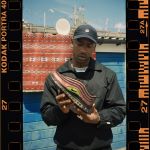
The urban importance of 'grime fashion'
The ultimate London revolution
August 17th, 2017
It is the beginning of the century when in the streets of the suburbs of London and the whole of England the OG garage music scene begins to weaken, lose lymph but, instead, from every end there is a new beginning and from these very still current comes to life something that more than just a new musical current is a real cultural revolution that will take place in the course of the whole decade: it is the birth of the grime.
Grime is a revolution that sets its roots in London's strong urban multiculturalism and tells the frustration of the new British youth of the suburbs through syncopated rhythmic and bold statements that face the wave of mainstream rap and hip / hop from overseas, whose leitmotifs that are now decadent are no less than ardent lefts of the opulence and fame the public has brought to them.
The grime scene is what London needs in 2000: the grime scene is the punk 2.0 - strictly labeled UK.

Aside from the American MCs, the grime scene recalls its urban origins both in clothing and through its initial diffusion, based on the use of pirated radio stations such as Rinse FM, to raise controversy and tell about teenage wasteland and political discontent. That's Not Me, by Boy Better Know's Skepta, is a real manifesto of grime culture, witnessing the fact that beyond this genre, besides music, there is much more: a form of activism aimed at regaining the authenticity of the street from its music to all its aspects - also through a new uniform.
#1 THE TRACKSUITMAFIA
The tracksuit is the uniform of every grime artist wearing this name, a garment that transcends its nature as a sportswear. The grime fashion is what you live in the street, a repulsion of the aesthetic that preceded it: from pompousness to urban minimalism.
"(...) went to the show sitting in the front row,
In the black tracksuit and it's shutdown"
#2 THE AIR MAX ARMY
Nike is the par excellence brand we are referring to in the English grime scene. If the tracksuit can range from emerging brand giants such as Nasir Mazhar, the shoe is one and only one: the Nike Air Max. An element so rooted in the imaginative grime that the Air Max 95, one of the Air Max models considerably crucial for the reading of the grime aesthetic, was simply called "the 110" because of its almost unattainable price for a working class exponent.
#3 THE SIX PANELS
The New Era hats have been among the first elements that have distinguished grime fashion since its inception, and the grime has their subsequent role in the indie, new rave and club house scenes.
#4 THE JACKET GAME
At the beginning of the century, the Avirex jacket was worn as a distinctive element of the garage scene becoming a symbol of excess and glamor. In the grime age, the same jacket is restored as a counterculture element to completely break away from the original brand and becoming a feature of the grime style and declining itself in its more sportswear version.
#5 THE REALNESS
As a contrast to Amercan MC's women-machine-pimp cups lifestyles, grime remains faithful to its origins. Grime is the sound coming from the London suburbs, the cracking of the neon lamps, the urban panorama sparked by tv aerials hanging, afternoons in the redecorated industrial homes, sitting on a scooter and thinking about how to change the world.
" (..) I wanted to get back to wearing clothes that are for us. The marketing teams at Nike and JD Sports, they came for us. The people modeling in the windows are people like Jamal from SBTV.
I want the kids to see that maybe they should be aligning themselves not just with a price range, but the people who are designing for you"*
What is certain is that, within a decade, the grime scene has been powerfully positioned itself in English reality as a street culture bastion attracting attention not only to a new broader public outside of East London but to Institutional brands and young talent that I want to take part in the creation of one of the aesthetics that will surely define the years to come.
What the future looks forward to, nobody knows for sure, but we do not doubt that new, glorious collaborations are waiting just around the corner, waiting to be revealed.


































































